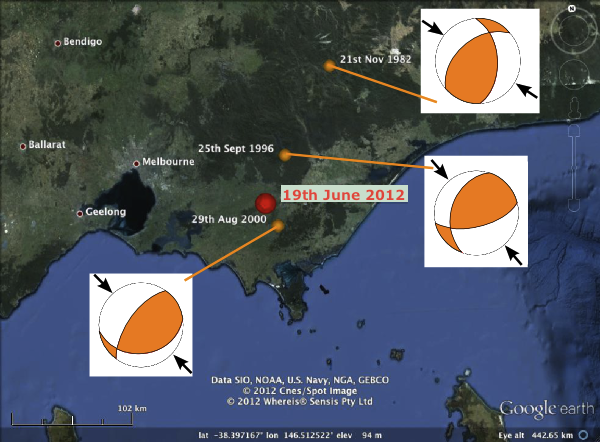![]() Rather annoyingly, I’ve actually been unable to find a focal mechanism for the magnitude 5.2 earthquake that shook the state of Victoria in southeast Australia on Tuesday. Although there were no reports of major damage, the relatively shallow depth of the rupture meant that people over a wide area felt the shaking, including a friend of mine who lives in Melbourne.
Rather annoyingly, I’ve actually been unable to find a focal mechanism for the magnitude 5.2 earthquake that shook the state of Victoria in southeast Australia on Tuesday. Although there were no reports of major damage, the relatively shallow depth of the rupture meant that people over a wide area felt the shaking, including a friend of mine who lives in Melbourne.
[blackbirdpie url=”http://twitter.com/syntype/status/215434334683926528″]
What makes things even more tricky is the fact that this was an interplate earthquake, occurring far from any active plate boundary. Rather than being caused by deformation between two tectonic plates that are moving around the planet at different speeds and in different directions to each other, it was the result of deformation within the Australian plate itself. When an earthquake occurs at or near a plate boundary, since we know how the two plates are moving relative to each other, we can at least make a reasonable guess as to whether it is caused by compression or extension, and even what direction that compression or extension is occurring in. In contrast, interplate earthquakes are driven by forces that are more distant, and more subtle, and happen on old, reactivated faults that were formed in a tectonic episode that is now long finished. All this makes it hard to make even a marginally educated guess as to what sort of focal mechanism we might expect.
Fortunately, earthquakes also rarely occur in complete isolation, and I managed to dig up this report from Geoscience Australia that lists all known Australian earthquakes for which focal mechanisms have been determined (the fact that you can actually do this without producing a telephone directory tells you something about how seismically active Australia…isn’t). This list contained three moderately large (body wave magnitudes of 4.7-5.0) earthquakes in the same area as Tuesday’s event, which I’ve plotted together with their listed focal mechanisms in the figure below:

Locations and focal mechanisms of significant earthquakes in Victoria in the past 20 years (orange dots), compared to location of the M 5.2 earthquake on 19th June 2012 (red dot)
As you can see, these focal mechanisms (as well as two smaller aftershocks of the August 2000 event, which I didn’t plot) rather consistently show northwest-southeast compression on northeast-southwest oriented faults. This consistency suggests there might be a uniform regional stress field acting on the crust in this region – and that there are a number of old faults with similar (NE-SW) trends being reactivated in response to this stress. Based on this, suggesting that Tuesday’s earthquake was similar to these other three seems like a reasonable hypothesis. And whilst we’re guessing, I’d guess the dominance of northeast-southwest trending faults in this area may be due to it being at the southern end of the Great Dividing Range, a series of mountain belts that runs along the entire east coast of Australia; their formation would have produced lots of thrust faults in this orientation.
Of course, I could easily be wrong; if and when someone produces a focal mechanism, I’ll let you know.




Nice plan for content warnings on Mastodon and the Fediverse. Now you need a Mastodon/Fediverse button on this blog.